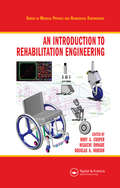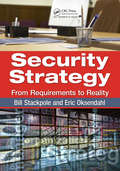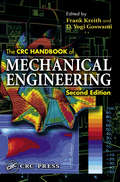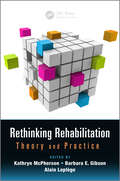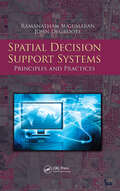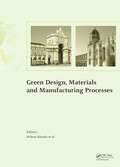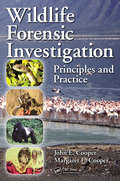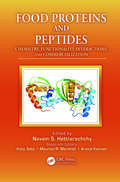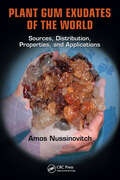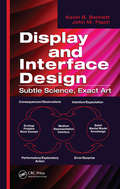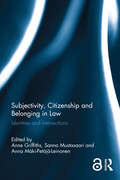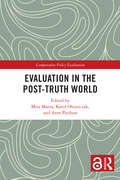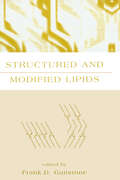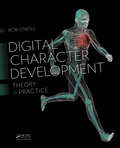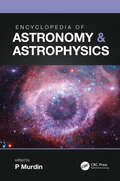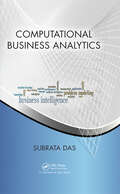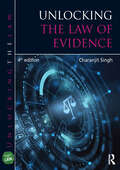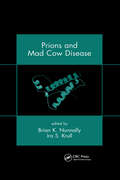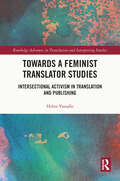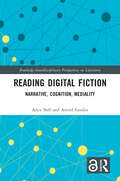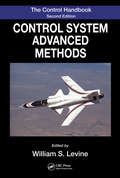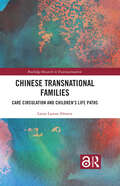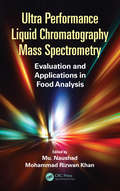- Table View
- List View
An Introduction to Rehabilitation Engineering (ISSN)
by Hisaichi Ohnabe Douglas A. Hobson Rory A. CooperThis resource focuses on the principles, modeling, standards, devices, and technologies of rehabilitation engineering and assistive technology. It describes numerous design models and processes, including participatory action design and service delivery models. The book also discusses the components of devices such as cushions, wheelchairs, prostheses, orthoses, hearing aids, and TTYs. The contributors assess industry standards and explore innovative technology aids, such as sensors, robot-assisted therapy, and speech recognition software. The text contains a set of learning objectives and study questions in each chapter as well as a list of definitions at the end of the book.
Security Strategy: From Requirements to Reality
by Bill Stackpole Eric OksendahlClarifying the purpose and place of strategy in an information security program, this book explains how to select, develop, and deploy the security strategy best suited to your organization. It focuses on security strategy planning and execution to provide a comprehensive look at the structures and tools needed to build a security program that enables and enhances business processes. Divided into two parts, the first part considers business strategy and the second part details specific tactics that support the implementation of strategic planning initiatives, goals, and objectives.
The CRC Handbook of Mechanical Engineering (Handbook Series for Mechanical Engineering)
by D. Yogi Goswami Frank KreithThe second edition of this standard-setting handbook provides and all-encompassing reference for the practicing engineer in industry, government, and academia, with relevant background and up-to-date information on the most important topics of modern mechanical engineering. These topics include modern manufacturing and design, robotics, computer engineering, environmental engineering, economics, patent law, and communication/information systems. The final chapter and appendix provide information regarding physical properties and mathematical and computational methods. New topics include nanotechnology, MEMS, electronic packaging, global climate change, electric and hybrid vehicles, and bioengineering.
Rethinking Rehabilitation: Theory and Practice (Rehabilitation Science in Practice Series)
by Kathryn McPherson Barbara E. Gibson Alain LeplègeThis book informs readers about how leading researchers are rethinking rehabilitation research and practice. It emphasizes discussion on the place of theory in advancing rehabilitation knowledge, unearthing important questions for policy and practice, underpinning research design, and prompting readers to question clinical assumptions. Each author proposes ways of thinking that are informed by theory, philosophy, and/or history as well as empirical research. Rigorous and provocative, it presents chapters that model ways readers might advance their own thinking, learning, practice, and research.
Teaching Architecture: The New Age of Digital Design (Routledge Focus on Design Pedagogy)
by Sadiyah GeyerIn the post-COVID era, understanding the profound impact of digital technologies on design pedagogy is crucial. This book delves into experimental design education, showcasing projects utilising technology to transform creative and analytical processes.Emphasising the potential for digital-era technologies to create novel educational opportunities, the book addresses recent global events and their role in minimising educational disruptions in the evolving hybrid educational landscape. Each chapter offers case studies exploring digital technology's influence across architectural education, spanning interior design, urban planning, parametric digital design, architectural conservation, and design analysis. Contributors envision the hybrid virtual design studio’s future and discuss the collaborative role of digital technologies in urban design projects. The book analyses contemporary parametric design processes and machine learning through innovative historical case studies, examining new technologies in architectural conservation.With case studies from diverse locations, including South Africa, Turkey, the UK, and the United States, the book provides a global perspective on the influences and potential futures of digital technologies in architecture. Essential for those interested in the future of spatial design education, this book illuminates the pivotal role of technology in shaping its trajectory.
Spatial Decision Support Systems: Principles and Practices
by Ramanathan Sugumaran John DegrooteThis book provides a comprehensive examination of the various aspects of SDSS evolution, components, architecture, and implementation. Integrating research from a variety of disciplines, it supplies a complete overview of SDSS technologies and their application. This groundbreaking reference provides thorough coverage of the roots of SDSS. It explains the core principles of SDSS, how to use them in various decision making contexts, and how to design and develop them using readily available enabling technologies and commercial tools.
Green Design, Materials and Manufacturing Processes
by José Pinto Duarte Filipa Roseta Helena Maria Bártolo Henrique Amorim Almeida Flávio Craveiro Paulo Jorge da Silva Bártolo Nuno Manuel Fernandes Alves Artur Jorge Mateus Ana Cristina Soares Lemos Carina Ramos Igor Reis Lina Durão Telma Ferreira Eduardo Castro e Costa Filipe Quaresma João Paulouro NevesGreen Design, Materials and Manufacturing Processes includes essential research in the field of sustainable intelligent manufacturing and related topics, containing reviewed papers presented at the 2nd International Conference on Sustainable Intelligent Manufacturing 2013. Topics covered include Eco Design and Innovation, Energy Efficiency, Green and Smart Manufacturing, Green Transportation, Life-Cycle Engineering, Renewable Energy Technologies, Reuse and Recycling Techniques, Smart Design, Smart Materials, Sustainable Business Models and Sustainable Construction. Intended for engineers, architects, designers, economists and manufacturers dealing with key sustainability issues.
Wildlife Forensic Investigation: Principles and Practice
by John E. Cooper Margaret E. CooperProviding an in-depth introduction to the rapidly evolving field of wildlife forensics, this volume also chronicles aspects of the history of management, conservation, and environmental protection, with an emphasis on their global importance in the twenty-first century. The book examines the crucial role of wildlife forensic investigation with regard to live animals, dead animals, and samples and covers national, regional, and international legislation. The book discusses animal welfare as well as the damage that can be inflicted on humans and property by wildlife. The text is enhanced by case studies from experts who describe some of their own work.
Food Proteins and Peptides: Chemistry, Functionality, Interactions, and Commercialization
by Navam S. HettiarachchyA multidisciplinary resource, this volume enables researchers to understand the physicochemical and biochemical factors that govern the functionality of food peptides and proteins. Following chapters on structure and chemistry, the book describes modes of characterization and the functional relationships of food proteins. It examines solubility and insolubility and explores proteins and peptides as emulsifying and foaming agents. Final chapters review future industrial perspectives and explore the role of nanotechnology in protein research. With contributions from a panel of international scientists, this volume captures the state of the art in protein and peptide research, providing a launching pad for further inquiry and discovery.
Plant Gum Exudates of the World: Sources, Distribution, Properties, and Applications
by Amos NussinovitchConsidered magicians of the ingredient world, gums (hydrocolloids) are used in a variety of food applications. They possess excellent thickening, binding, emulsifying, suspension, and viscosity properties. The first comprehensive reference produced on gums in 60 years, this work is organized by taxonomy. Each entry contains the botanical name and synonyms of the tree from which it is exuded, common names, geographic distribution, chemical characteristics and structural features, physical properties, and industrial and food applications. The uses of other parts of the trees from which the gums originate are also detailed. Entries are illustrated with color photos and line drawings.
Display and Interface Design: Subtle Science, Exact Art
by John M. Flach Kevin B. BennettThe reason that good interfaces are few and far between is really quite simple: they are extremely difficult to design and build properly. While there are many books available that address display design, most of them focus on aesthetic principles but lack scientific rigor, or are descriptive but not prescriptive. This book elucidates an overarching framework for design that can be applied to the broad spectrum of existing domains. The authors delineate analytical tools and principles of design that are general and powerful, but very abstract, accompanied by concrete examples of their use in a variety of domains of application. The book includes access to a web site containing examples of the dynamic properties of displays.
Subjectivity, Citizenship and Belonging in Law: Identities and Intersections
by Anne Griffiths Sanna Mustasaari Anna Mäki-Petäjä-LeinonenThis collection of articles critically examines legal subjectivity and ideas of citizenship inherent in legal thought. The chapters offer a novel perspective on current debates in this area by exploring the connections between public and political issues as they intersect with more intimate sets of relations and private identities. Covering issues as diverse as autonomy, vulnerability and care, family and work, immigration control, the institution of speech, and the electorate and the right to vote, they provide a broader canvas upon which to comprehend more complex notions of citizenship, personhood, identity and belonging in law, in their various ramifications.Chapter 7 of this book is freely available as a downloadable Open Access PDF at http://www.taylorfrancis.com under a Creative Commons Attribution-Non Commercial-No Derivatives (CC-BY-NC-ND) 4.0 license.
Evaluation in the Post-Truth World (Comparative Policy Evaluation)
by Mita Marra, Karol Olejniczak, and Arne PaulsonEvaluation in the Post-Truth World explores the relationship between the nature of evaluative knowledge, the increasing demand in decision-making for evaluation and other forms of research evidence, and the post-truth phenomena of antiscience sentiments combined with illiberal tendencies of the present day. Rather than offer a checklist on how to deal with post-truth, the experts found herein wish to raise awareness and reflection throughout policy circles on the factors that influence our assessment and policy-related work in such a challenging environment. Journeying alongside the editor and contributors, readers benefit from three guiding questions to help identify specific challenges but tools to deal with such challenges: How are policy problems conceptualized in the current political climate? What is the relationship between expertise and decision-making in today’s political circumstances? How complex has evaluation become as a social practice?Evaluation in the Post-Truth World will benefit evaluation practitioners at the program and project levels, as well as policy analysts and scholars interested in applications of evaluation in the public policy domain.Chapters 6, and 11 of this book are freely available as a downloadable Open Access PDF at http://www.taylorfrancis.com under a Creative Commons [Attribution-Non Commercial-No Derivatives (CC-BY-NC-ND)] 4.0 license.
Structured and Modified Lipids
by Frank D. GunstoneThis text addresses critical topics in the expanding market and production for lipids. It combines novel and traditional methods from technological and biological perspectives to achieve the most effective pathways for production of modified lipids. The book is organized into three sections exploring development, new production methods and successful products and uses.Structured and Modified Lipids provides a comprehensive exploration of issues related to lipids production and marketing. It combines novel and traditional methods from technological and biological perspectives to achieve the most effective pathways for production of modified lipids. The book is organized into three sections highlighting development, new production methods
Digital Character Development: Theory and Practice, Second Edition
by Rob O'NeillEvery animated film and video game production spends a large percentage of its resources and time on advancing the quality of the digital characters inhabiting the world being created. This book presents the theory and practice behind the creation of digital characters for film and games using software-agnostic descriptions that apply to any animation application. It provides insight from a real production environment and the requirements that such an environment imposes. With rich illustrations and visual code examples throughout, this book provides a comprehensive roadmap to character development for both professionals and students.
Encyclopedia of Astronomy & Astrophysics
by Paul MurdinIn a unique collaboration, Nature Publishing Group and Institute of Physics Publishing have published the most extensive and comprehensive reference work in astronomy and astrophysics. This unique resource covers the entire field of astronomy and astrophysics and this online version includes the full text of over 2,750 articles, plus sophisticated search and retrieval functionality and links to the primary literature. The Encyclopaedia's authority is assured by editorial and advisory boards drawn from the world's foremost astronomers and astrophysicists. This first class resource is an essential source of information for undergraduates, graduate students, researchers and seasoned professionals, as well as for committed amateurs, librarians and lay people wishing to consult the definitive astronomy and astrophysics reference work.
Computational Business Analytics (Chapman & Hall/CRC Data Mining and Knowledge Discovery Series #34)
by Subrata DasThis book presents tools and techniques for descriptive, predictive, and prescriptive analytics applicable across multiple domains. The author first covers core descriptive and inferential statistics for analytics and then enhances numerical statistical techniques with symbolic artificial intelligence and machine learning techniques for richer predictive and prescriptive analytics. Through many examples and challenging case studies from a variety of fields, practitioners easily see the connections to their own problems and can then formulate their own solution strategies.
The Economic Viability of Micropolitan America (Public Administration and Public Policy)
by Gerald L. GordonThis book addresses the economic history and future of small cities and towns across the country, as they have and will continue to see dramatic shifts in the roles they play in the extant larger economies. The book addresses the difficult questions asked by these communities as they face an uncertain future. Can the small cities and towns of this country survive and, if so, what economic roles can they play? Must they return to the days of being essentially self-sufficient? Or, is it possible that they will become epicenters of progress in the United States?
Unlocking the Law of Evidence (Unlocking the Law)
by Charanjit SinghUnlocking the Law of Evidence will help you grasp the main concepts of the subject with ease. Containing accessible explanations in clear and precise terms that are easy to understand, it provides an excellent foundation for learning and revising Evidence. The information is clearly presented in a logical structure and the following features support learning, helping you to advance with confidence: Clear learning outcomes at the beginning of each chapter set out the skills and knowledge you will need to get to grips with the subject Key Facts summaries throughout each chapter allow you to progressively build and consolidate your understanding End-of-chapter summaries provide a useful check-list for each topic Cases and judgments are highlighted to help you find them and add them to your notes quickly Frequent activities and self-test questions are included so you can put your knowledge into practice Sample essay questions with annotated answers prepare you for assessment Glossary of legal terms clarifies important definitions. This edition has been updated to include the most recent updates in case law and criminal and civil procedure as well as more practical pointers and practice tips to further aid putting knowledge into practice.The books in the UNLOCKING THE LAW Series get straight to the point and offer clear and concise coverage of the law, broken down into bite-size sections with regular recaps to boost your confidence. They provide complete coverage of both core and popular optional law modules, presented in an innovative, visual format.
Prions and Mad Cow Disease
by Brian K. Nunnally Ira S. KrullThe alarm sounded by Canada's confirmed case of bovine spongiform encephalopathy (BSE) has reaffirmed the exigency of establishing improved safeguards and more aggressive surveillance protocols in North America and around the world. Research converging on the probable causative agent--prion proteins--calls for intensive assessment of the headway gained in tracing prions, testing for transmissible neurodegenerative diseases, and developing methods for cornering the epidemic. With an illustrious panel of 36 international contributors, this timely book marshals techniques for prion protein assay and diagnosis of transmissible spongiform encephalopathies (TSEs).
Towards a Feminist Translator Studies: Intersectional Activism in Translation and Publishing (ISSN)
by Helen VassalloThis pioneering work advocates for a shift toward inclusivity in the UK translated literature landscape, investigating and challenging unconscious bias around women in translation and building on existing research highlighting the role of translators as activists and agents and the possibilities for these new theoretical models to contribute to meaningful industry change.The book sets out the context for the new subdiscipline of feminist translator studies, positing this as an essential mechanism to work towards diversity in the translated literature sector of the publishing industry. In a series of five case studies that each exemplify a key component of the feminist translator studies "toolkit", Vassallo draws on exclusive interviews with a range of activist translators and publishers, setting these in dialogue with contemporary perspectives on feminism and translation to propose a new agent-based model of feminist translation practice. In synthesising these perspectives, Vassallo makes a powerful argument for questioning existing structures in the translated literature publishing system which perpetuate bias and connects these conversations to wider social movements towards promoting demonstrable change in the industry.This book will be a valuable resource for students and scholars of translation studies and publishing, as well as for the various agents involved in promoting translated literature in the UK and beyond.
Reading Digital Fiction: Narrative, Cognition, Mediality (Routledge Interdisciplinary Perspectives on Literature)
by Astrid Ensslin Alice BellReading Digital Fiction offers the first comprehensive and systematic theoretical, methodological, and analytical examination of digital fiction from a cognitive and empirical perspective. Proposing the new concept of “medial reading”, it argues for the centrality of an audience’s interest in, awareness of and/or attention to the medium in which a text is produced and received, and which we argue should be applied to reader data across media. The book analyses and theorises five generations of digital fiction and their reading including hypertext fiction, hypermedia fiction, narrative video games, app fiction, and virtual reality. It showcases medium- and platform-specific methods of qualitative reader response research across a variety of contexts and settings from screen-based and embodied interaction to gallery installation, and from reading group and individual interview to think-aloud methodologies. The book thus addresses the unique affordances of digital fiction reading by designing and reporting on new empirical studies focusing on hypertextuality, interactivity, immersion, as well as medium-specific forms of textual “you”, ontological ambiguity, reader orientation and empathy. In so doing, the book refines, critiques, and expands cognitive, transmedial, and empirical narratology and stylistics by placing the reader of these new narratives front and centre.The Open Access version of this book, available at http://www.taylorfrancis.com, has been made available under a Creative Commons [Attribution-Non Commercial-No Derivatives (CC-BY-NC-ND)] 4.0 license.
The Control Systems Handbook: Control System Advanced Methods, Second Edition (ISSN)
by William S. LevineAt publication, The Control Handbook immediately became the definitive resource that engineers working with modern control systems required. Among its many accolades, that first edition was cited by the AAP as the Best Engineering Handbook of 1996. Now, 15 years later, William Levine has once again compiled the most comprehensive and authoritative resource on control engineering. He has fully reorganized the text to reflect the technical advances achieved since the last edition and has expanded its contents to include the multidisciplinary perspective that is making control engineering a critical component in so many fields. Now expanded from one to three volumes, The Control Handbook, Second Edition organizes cutting-edge contributions from more than 200 leading experts. The third volume, Control System Advanced Methods, includes design and analysis methods for MIMO linear and LTI systems, Kalman filters and observers, hybrid systems, and nonlinear systems. It also covers advanced considerations regarding — Stability Adaptive controls System identification Stochastic control Control of distributed parameter systems Networks and networked controls As with the first edition, the new edition not only stands as a record of accomplishment in control engineering but provides researchers with the means to make further advances. Progressively organized, the first two volumes in the set include: Control System Fundamentals Control System Applications
Chinese Transnational Families: Care Circulation and Children’s Life Paths (Routledge Research in Transnationalism)
by Laura Lamas-AbrairaThe research presented in this book explores care and its circulation in Chinese transnational families that are split between China and Spain, and the paths these families’ children have taken through their lives so far: from their early years to their current position as young adults, with care, in its multiple dimensions and timescales – past, present and future – as the unifying thread.In doing so, it provides a contribution to the emerging body of research about care and transnational families and it posits the need to question hegemonic models of family, childhood and care, and to give voice and visibility to other actors, moving beyond the adult-centred perspective that dominates migration research.The ethnographic approach together with the focus on the day-to-day lives of these families, in which care is the core concept, as it permeates people’s lives and traverses society generationally, makes this book appealing to both scholars and general public.
Ultra Performance Liquid Chromatography Mass Spectrometry: Evaluation and Applications in Food Analysis
by Mu. Naushad Mohammad Rizwan KhanThis book presents a unique collection of up-to-date UPLC-MS/MS (ultra performance liquid chromatography-tandem mass spectrometric) methods for the separation and quantitative determination of pesticides, capsaicinoids, heterocyclic amines, aflatoxin, perfluorochemicals, acrylamide, procyanidins and alkaloids, lactose content, phenolic compounds, vitamins, and aroma and flavor compounds in a wide variety of foods and food products. With contributions by experts in interdisciplinary fields, this reference offers practical information for readers in research and development, production, and routing analysis of foods and food products.
